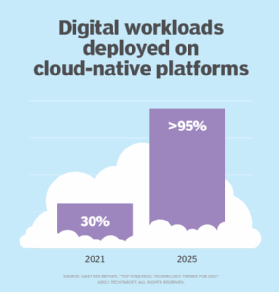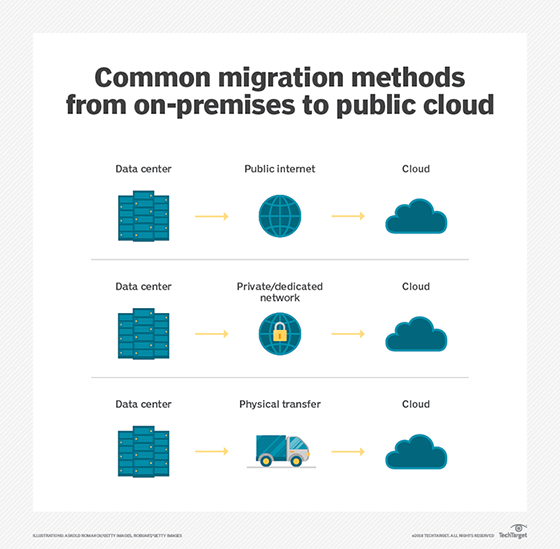
ra2 studio - Fotolia
Top cloud migration and adoption trends for 2022 and beyond
Cloud migrations are inevitable for some enterprises as they navigate a move off premises or between clouds. Evaluate some of the latest migration trends and the pros and cons that come with each.
The last couple of years have brought a significant shift in how enterprises think and use the cloud -- and the pandemic only hastened these cloud migration initiatives.
Companies that only explored how to migrate apps and workloads to the cloud have dramatically accelerated those plans to stay relevant and survive in an era of upheaval to the economic environment, supply chains and new business models.
As organizations continue to shift gears to match strategic plans and respond to macroeconomic factors, expect these nine key trends to drive cloud migration in 2022 and beyond.
1. Tech and human factors more sharply align
Technology is often the most straightforward part of large-scale transformation efforts, such as cloud migration, but multiple human factors come into play as well -- and they can be much more challenging, said Bernie Hoecker, partner and enterprise cloud transformation leader with global technology research and advisory firm Information Services Group (ISG) in Stamford, Conn. "Transparency, global access, political discord and socioeconomic factors also serve as catalysts for cloud acceleration across the world," he said.
The pandemic more concretely and urgently aligned both human interests and technology, and enterprises have channeled these toward cloud efforts.
"When technology and human nature combine to attack a common enemy, such as dealing with COVID, there are no bounds to innovation and new paradigms," Hoecker said.
2. Migration inspires modernization
Initially, migrations to the public cloud were seen as a straightforward way to quickly replace data center infrastructure with VMs and storage -- but not change the apps themselves -- Gartner analyst Craig Lowery said. Once in the cloud, however, enterprises realized that the lift-and-shift approach did little to unlock the cloud's true potential to enable enterprise innovations.

More cloud adopters now see that they must update their critical applications to realize all of the cloud's benefits. This, he said, is the most profound trend driving cloud migrations: the desire to modernize applications as part of the process and achieve more transformational business outcomes.
3. Digital transformation accelerates
The pandemic motivated enterprises to pick up the pace on initiatives to explore and implement digital transformation initiatives. Initially, this was to bring traditional business online and adopt tools to develop innovative products and better enable digital experiences for customers, said Kaushik De, applications and cloud analyst at Capgemini.
Now, he sees more businesses that want to infuse enterprise apps with multi-cloud and hybrid cloud architectures, edge computing, anything as a service, containerization and serverless computing.
4. Analytics drives data migration
Business leaders developed cloud migration strategies to help make sense of the rapidly changing business environment. Most cloud providers support tools to weave data into new analytics and apply business intelligence (BI) to keep pace with business changes.
Those vendors continue to perfect their analytics tooling, and many have produced industry-specific analytics offerings, said Tanmay Baxi, senior solutions architect at Infostretch, a digital engineering services firm in Santa Clara, Calif. Companies increasingly face challenges to make on-premises data warehouses more nimble. These new cloud services make it easier to incorporate BI and analytics workflow and take advantage of richer data streams across supply chains and new data services.
5. Distributed cloud expands
Application modernization will continue to rise in importance, but migration strategies will further evolve to consider multi-cloud and distributed cloud opportunities, Gartner's Lowery said. Enterprises often deploy workloads in more than one cloud, usually due to an accident or lack of coordination, he said. Now, companies more deliberately analyze the specific value of the different clouds. This more thoughtful analysis encourages ways to purposefully take advantage of best-of-breed services across cloud providers.
In addition, new connectivity options, such as 5G, will make cloud services more available at the edge and in on-premises locations. Lowery expects cloud adopters to increasingly pursue complex cloud migrations to deploy applications nearer to where they will be used.
6. Improved user experiences become a focus
Because the pandemic forced many people to work from home, workers and consumers now expect a better digital experience, and these expectations will continue to influence cloud migration, said Randy Armknecht, managing director at Protiviti, an IT consultancy based in Menlo Park, Calif. Users and consumers now want to see the convenient and modern experience they have with large media and social media platforms in all aspects of their digital lives.
Companies should consider their overall digital experience -- for both internal and external users -- as part of their cloud migration strategy. Cloud services can make it easier to rapidly prototype and test different UX ideas to find out what is most helpful to users.

7. Templated processes accelerate cloud-native efforts
Enterprises have expanded their use of cloud-native technologies to improve their applications' performance and scalability. However, many companies struggle with a cloud-native journey that can be long, fraught with assumptions and reliant on a small core of experts, said Yugal Joshi, partner at Everest Group, a Dallas-based management consulting company.
As cloud-native adoption grows, enterprises will demand a more templatized approach, rather than depend on the gut feelings of developers and architects, he said.
8. FinOps gains momentum
Companies are looking even more closely at cloud from an ROI perspective, Joshi said. The need to balance financial considerations of the business with technical requirements has spawned the development of financial ops, or FinOps, as a new role in many organizations.
Look for a new cadre of FinOps executives to emerge. They'll be orchestrators, across IT and business teams, to examine cloud cost considerations in all cloud migration discussions.
9. Businesses and vendors embrace cleaner tech
Enterprises have talked about green computing for years, mostly as a distant consideration. Now, they are more sensitive to concerns about climate change, flooding, fires and social justice, as these become increasingly important to consumers, employees and management.
Sustainability initiatives, such as environmental, social and governance concerns, will play a more significant role in cloud migration decisions, ISG's Hoecker said. Cloud computing can often reduce a company's data center footprint through greater efficiency. At the same time, expect cloud providers to invest more in renewable energy.






